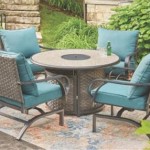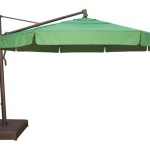Wrought Iron Patio Furniture Replacement Feet: A Comprehensive Guide
Wrought iron patio furniture offers enduring style and durability, making it a popular choice for outdoor spaces. However, like any furniture exposed to the elements, the feet of wrought iron pieces are susceptible to wear and tear. Rust, corrosion, and physical damage from abrasive surfaces can lead to deterioration, compromising the stability and aesthetic appeal of the furniture. Replacing worn or damaged feet is often more cost-effective than replacing the entire piece and can significantly extend the lifespan of beloved patio sets. This article provides a comprehensive guide to understanding the need for replacement feet, identifying suitable options, and exploring the process of replacing them effectively.
Understanding the Necessity of Replacement Feet
The feet of wrought iron patio furniture serve several critical functions. Primarily, they provide a stable base, preventing the furniture from wobbling or tipping over. This is particularly important on uneven surfaces like patios, decks, or lawns. Secondly, they act as a buffer between the wrought iron and the ground, preventing direct contact with moisture and abrasive materials. This protective barrier minimizes the risk of rust and corrosion, which are common problems with outdoor wrought iron furniture. Finally, the feet contribute to the overall aesthetic of the furniture. Worn, damaged, or missing feet can detract from the visual appeal, making the furniture look neglected and uncared for.
Several factors contribute to the degradation of wrought iron patio furniture feet. Exposure to the elements, including rain, snow, and sunlight, accelerates the rusting process. Moisture, in particular, is a catalyst for corrosion. Abrasive surfaces, such as concrete patios or rough stone, can gradually wear down the metal, leading to thinning and eventual failure. The weight of the furniture and the people using it also puts stress on the feet, increasing the likelihood of bending, cracking, or breaking. Furthermore, neglecting regular maintenance, such as cleaning and rust prevention, can exacerbate the problem.
Ignoring damaged or missing feet can lead to more significant problems. Unstable furniture poses a safety hazard, increasing the risk of accidents and injuries. As mentioned, direct contact between the wrought iron and the ground accelerates corrosion, potentially weakening the entire structure of the furniture. The cost of repairing or replacing the entire piece of furniture will ultimately exceed the cost of simply replacing the feet. Therefore, proactive replacement of worn or damaged feet is a wise investment in the longevity and safety of the patio furniture.
Identifying the Right Replacement Feet
Selecting the appropriate replacement feet is crucial for ensuring a proper fit, long-lasting performance, and aesthetic consistency. Several factors must be considered during the selection process, including the type of furniture, the size and shape of the existing feet, the material of the replacement feet, and the method of attachment.
The type of furniture will dictate the appropriate style and function of the replacement feet. For example, a dining chair will require different feet than a lounge chair or a table. The chair feet should be designed to provide stability and prevent scratching of the patio surface, while table feet may need to be adjustable to accommodate uneven ground. Consider the specific design of the existing feet. Are they round, square, or another shape? Are they angled or straight? Accurately measuring the dimensions of the existing feet, including the diameter or width, height, and the size of any mounting hardware, is essential for finding a compatible replacement. If the original feet are custom or no longer available, consider selecting a universal replacement foot that can be adapted to fit the furniture.
The material of the replacement feet is another important consideration. Plastic feet are inexpensive and relatively durable, but they may not be as aesthetically pleasing as metal feet. Metal feet, such as steel or aluminum, offer greater strength and durability, but they are also more prone to rust and corrosion if not properly treated. Rubber feet provide excellent grip and can help to prevent scratching, but they may deteriorate over time, especially in harsh weather conditions. Composite materials, such as a combination of rubber and plastic, offer a balance of durability, grip, and weather resistance. The best material will depend on the environment, the aesthetic preferences, and the budget.
The method of attachment is also a critical factor. Some replacement feet simply slip over the existing furniture legs, while others require screws, bolts, or adhesive for secure attachment. Slip-on feet are the easiest to install, but they may not be as secure as feet that are bolted or screwed into place. If the furniture has threaded inserts, select replacement feet that are compatible with the existing hardware. If not, consider using self-tapping screws or epoxy adhesive to secure the feet to the furniture. The chosen method of attachment should ensure a secure and durable connection that will withstand the weight and stress of regular use.
The Replacement Process: A Step-by-Step Guide
Replacing wrought iron patio furniture feet is typically a straightforward process that can be completed with basic tools and minimal experience. However, it is essential to follow a systematic approach to ensure a successful and lasting repair. The following steps provide a comprehensive guide to the replacement process.
First, gather all the necessary materials and tools. This typically includes the replacement feet, a screwdriver or wrench (depending on the attachment method), a measuring tape, a wire brush or sandpaper, rust remover (if necessary), a primer and paint (if desired), and safety glasses. Prepare the work area by laying down a drop cloth or newspaper to protect the surrounding surfaces. It is advisable to work outdoors or in a well-ventilated area, especially when using rust remover or spray paint.
Next, remove the old feet. This may involve unscrewing or unbolting them, or simply prying them off with a screwdriver or putty knife. If the feet are rusted or corroded, applying a penetrating oil or rust remover can help to loosen them. Be careful not to damage the furniture legs during the removal process. Once the old feet have been removed, thoroughly clean the furniture legs. This involves removing any rust, dirt, or debris with a wire brush or sandpaper. If there is significant rust, apply a rust converter or remover to neutralize the corrosion. Wipe down the legs with a clean cloth to remove any residue.
If desired, prepare the metal for painting. Use a self-etching primer that is designed for metal surfaces. This will improve the adhesion of the paint and provide added protection against rust. Apply the primer in thin, even coats, allowing each coat to dry completely before applying the next. Once the primer is dry, paint the furniture legs with a rust-resistant paint that matches the color of the furniture. Apply several thin coats of paint, allowing each coat to dry completely before applying the next. This will create a durable and long-lasting finish.
Now, attach the replacement feet. If the feet are slip-on, simply slide them over the furniture legs to the appropriate depth. If the feet require screws or bolts, align them with the existing holes and tighten the fasteners securely. If the furniture does not have existing holes, use self-tapping screws or drill pilot holes before inserting the screws. Ensure that the feet are properly aligned and securely attached before putting weight on the furniture. If using adhesive, apply a generous amount of epoxy adhesive to the bottom of the furniture legs and attach the feet. Use clamps or tape to hold the feet in place while the adhesive cures according to the manufacturer's instructions. Allow the adhesive to fully cure before using the furniture.
Finally, inspect the repaired furniture and test its stability. Ensure that all the feet are securely attached and that the furniture is level and does not wobble. If necessary, adjust the feet or add shims to level the furniture. Clean up the work area and dispose of any waste materials properly. Regularly inspect the replacement feet for signs of wear and tear and perform maintenance as needed to ensure their longevity. Consider applying a rust preventative to the bare metal on the feet, particularly if it is prone to rusting.
By following these steps, one can successfully replace worn or damaged wrought iron patio furniture feet, extending the life of the furniture and enhancing the outdoor living space. The process is straightforward, cost-effective, and can be completed with basic tools and minimal expertise.

1 2 Inch Wrought Iron Patio Furniture Feet Glides 30 Pack Outdoor Chair Leg F Ebay

Impresa 32 Pack Of 1 5 Inch Patio Furniture Glides Feet Caps For Wrought Iron Outdoor Protect Your Floor Surfaces From Scratches Replacement Eight Chairs Sliders Walmart Com

Forever Glides Wrought Iron Patio Chair And Outdoor Furniture Replacement Feet Broe 24 Pack 1 2 Walmart Com

1 5 Inch Replacement Nylon Feet Insert Glides For Wrought Iron Garden Outdoor Furniture Rubber Product And Spare Parts Price Made In Com

Cast Aluminum Patio Furniture Parts Dolin Casting

Impresa 32 Pack Of 1 5 Inch Patio Furniture Glides Feet Caps For Wrought Iron Outdoor Protect Your Floor Surfaces From Scratches Replacement Eight Chairs Sliders Walmart Com

32x Replacement Leg Feet Caps Wrought Iron Patio Furniture Glides For Tables Ebay

Getuscart Forever Glides Wrought Iron Patio Chair And Outdoor Furniture Replacement Feet 24 Pack 1 2 Pewter

Project Patio 1 5 Inch Wrought Iron Furniture Feet Caps And Outdoor Table Chair Leg Floor Protector Replacement Insert Glide Parts 24 Pack Yahoo Shopping

The Ultimate Guide To Patio Furniture Feet Protectors Glides Sunniland In Boca Raton
See Also








